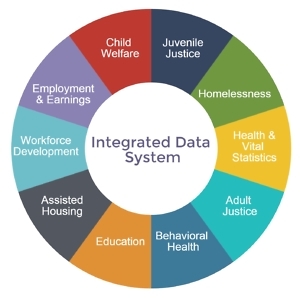 Programs and agencies in government often exist in silos, where the efforts of one aren’t necessarily connected with others and their data are not shared between them. That slows the process within government of learning what works, coordinating efforts, spurring social innovation, and continuous improvement.
Programs and agencies in government often exist in silos, where the efforts of one aren’t necessarily connected with others and their data are not shared between them. That slows the process within government of learning what works, coordinating efforts, spurring social innovation, and continuous improvement.
 A growing number of states and localities, however, are developing Integrated Data Systems by linking their program data, also called administrative data, across multiple agencies to monitor and track how services are being used and to what effect. These systems can also be used to test social policy innovations through quick, low-cost randomized control trials and quasi-experiments, as well as to do continuous quality improvement efforts and benefit cost analysis.
A growing number of states and localities, however, are developing Integrated Data Systems by linking their program data, also called administrative data, across multiple agencies to monitor and track how services are being used and to what effect. These systems can also be used to test social policy innovations through quick, low-cost randomized control trials and quasi-experiments, as well as to do continuous quality improvement efforts and benefit cost analysis.
To learn more, we’re joined by Dennis Culhane. He’s is a professor in the School of Social Policy and Practice at the University of Pennsylvania and the co-principal investigator of the nonprofit Actionable Intelligence for Social Policy (AISP) which has built a network of jurisdictions using Integrated Data Systems.
Credit: The graphic above is from AISP’s overview of Integrated Data Systems.